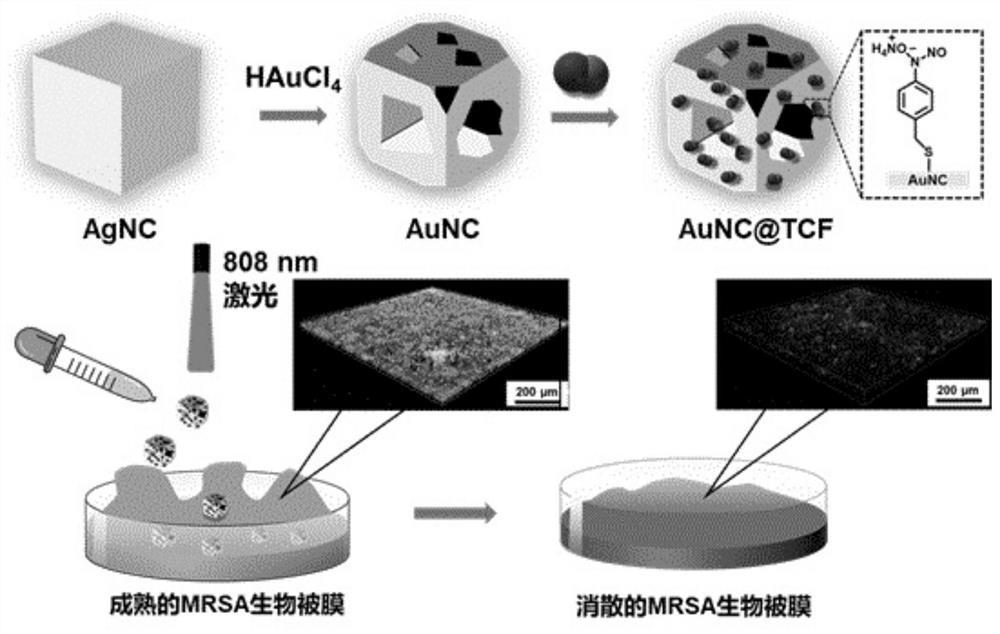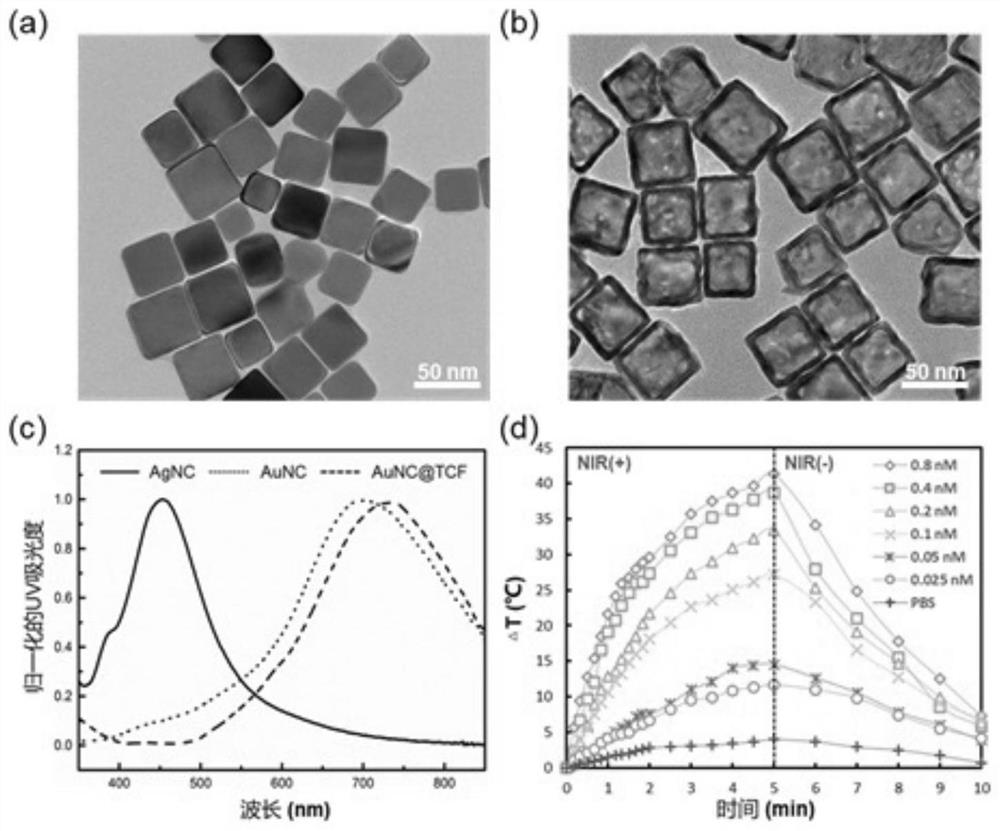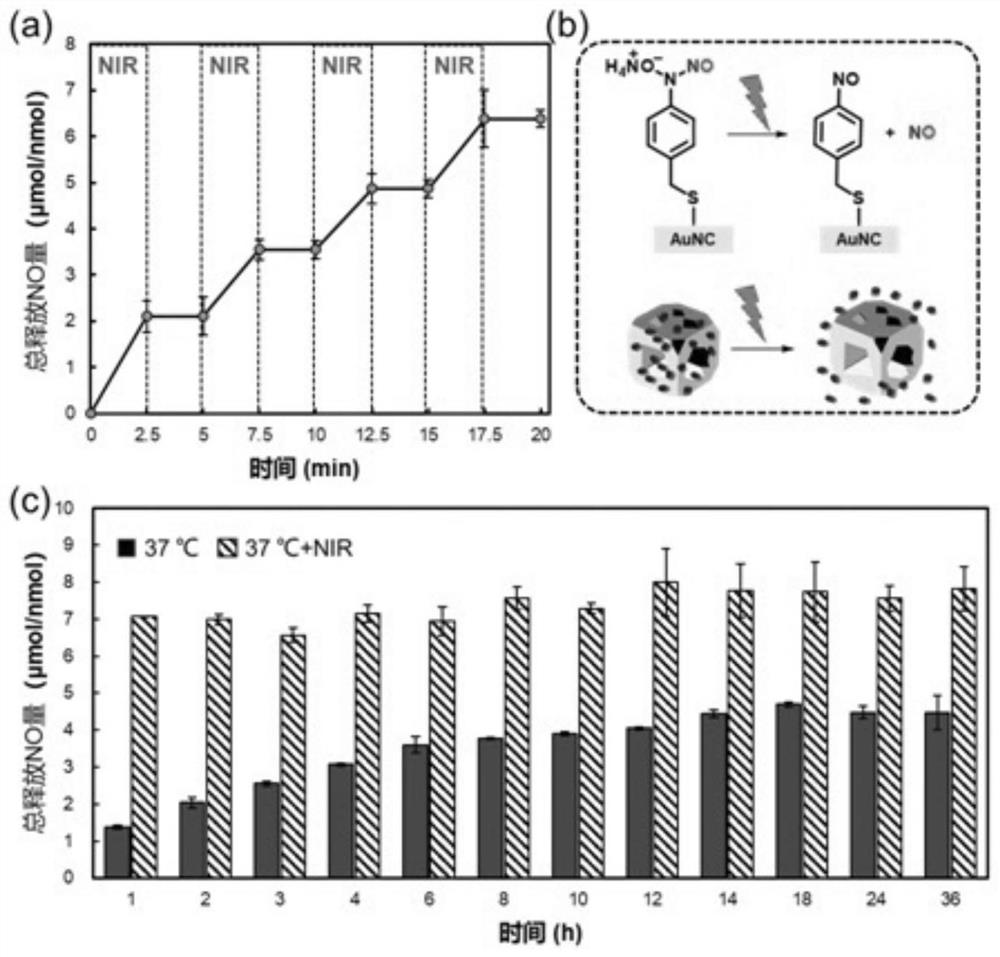A kind of gold nanocage material that releases NO anti-MRSA biofilm in response to light and its preparation method and application
A gold nanocage and biofilm technology, applied in the field of biomedical engineering materials, can solve the problems of limited NO bactericidal effect, bacterial infection control, difficult direct application, etc., to promote wound healing, good biocompatibility, and low hemolysis rate Effect
- Summary
- Abstract
- Description
- Claims
- Application Information
AI Technical Summary
Problems solved by technology
Method used
Image
Examples
Embodiment 1
[0034] This embodiment discloses a method for preparing a gold nanocage material that releases NO in response to light and resists MRSA biofilms, comprising the following steps:
[0035] (1) Preparation of AuNC: Heat 25mL of ethylene glycol to 150°C; keep at 150°C, 280rpm, quickly inject 0.3mL, 3mM NaHS solution into the above solution, and then add 2.5ml, 3mM hydrochloric acid solution at intervals of 2 minutes , 6.25mL, 20mg / mL of PVP solution and 2mL, 283mM of CF 3 COOAg solution, keep the original condition for 60min. Then the product was ice-bathed and then centrifuged with acetone (for the first time) and ultrapure water at 7500rpm to obtain AgNCs. Pour 50mL of ultrapure water into a round bottom flask, heat to 100°C while maintaining 250rpm, add 60μL, 5nM AgNCs, and then slowly add HAuCl dropwise to the mixed solution with a syringe pump 4 , and finally cooled in an ice bath, and then centrifuged with ultrapure water at 7500rpm for 3 times to obtain AuNC, and the prod...
Embodiment 2
[0049] This embodiment discloses a method for preparing a gold nanocage material that releases NO in response to light and resists MRSA biofilms, comprising the following steps:
[0050] (1) Preparation of AuNC: Heat 25mL of ethylene glycol to 150°C; keep at 150°C, 280rpm, quickly inject 0.3mL, 3mM NaHS solution into the above solution, and then add 2.5ml, 3mM hydrochloric acid solution at intervals of 2 minutes , 6.25mL, 20mg / mL of PVP solution and 2mL, 283mM of CF 3 COOAg solution, keep the original condition for 60min. Then the product was ice-bathed and then centrifuged with acetone (for the first time) and ultrapure water at 7500rpm to obtain AgNCs. Pour 50mL of ultrapure water into a round bottom flask, heat to 100°C while maintaining 250rpm, add 60μL, 5nM AgNCs, and then slowly add HAuCl dropwise to the mixed solution with a syringe pump 4 , and finally cooled in an ice bath, and then centrifuged with ultrapure water at 7500rpm for 3 times to obtain AuNC, and the prod...
Embodiment 3
[0054] This embodiment discloses a method for preparing a gold nanocage material that releases NO in response to light and resists MRSA biofilms, comprising the following steps:
[0055](1) Preparation of AuNC: Heat 25mL of ethylene glycol to 150°C; keep at 150°C, 280rpm, quickly inject 0.3mL, 3mM NaHS solution into the above solution, and then add 2.5ml, 3mM hydrochloric acid solution at intervals of 2 minutes , 6.25mL, 20mg / mL of PVP solution and 2mL, 283mM of CF 3 COOAg solution, keep the original condition for 60min. Then the product was ice-bathed and then centrifuged with acetone (for the first time) and ultrapure water at 7500rpm to obtain AgNCs. Pour 50mL of ultrapure water into a round bottom flask, heat to 100°C while maintaining 250rpm, add 60μL, 5nM AgNCs, and then slowly add HAuCl dropwise to the mixed solution with a syringe pump 4 , and finally cooled in an ice bath, and then centrifuged with ultrapure water at 7500rpm for 3 times to obtain AuNC, and the produ...
PUM
| Property | Measurement | Unit |
|---|---|---|
| size | aaaaa | aaaaa |
| size | aaaaa | aaaaa |
| size | aaaaa | aaaaa |
Abstract
Description
Claims
Application Information
 Login to View More
Login to View More - R&D
- Intellectual Property
- Life Sciences
- Materials
- Tech Scout
- Unparalleled Data Quality
- Higher Quality Content
- 60% Fewer Hallucinations
Browse by: Latest US Patents, China's latest patents, Technical Efficacy Thesaurus, Application Domain, Technology Topic, Popular Technical Reports.
© 2025 PatSnap. All rights reserved.Legal|Privacy policy|Modern Slavery Act Transparency Statement|Sitemap|About US| Contact US: help@patsnap.com



